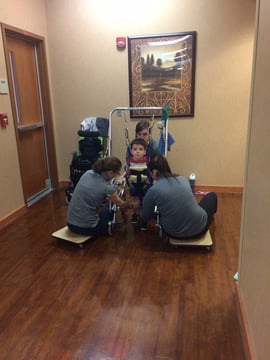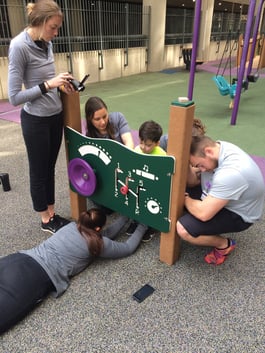NRN Spotlight: Frazier Rehab Institute Pediatric Program - Blog - Reeve Foundation
Out of the nearly 1.3 million people in the United States who live with a spinal cord injury, a number are children whose ages range from newborn to adolescent. While the occurrence of injury in children remains relatively low, for the families impacted by spinal cord injury, finding the right therapy and support is critical.
In the fall of 2012, Frazier Rehab Institute, part of the Christopher & Dana Reeve Foundation’s NeuroRecovery Network (NRN) located in Louisville, KY, expanded to include pediatric participants. In the fall of 2016, a second NRN pediatric site was added at the Children’s Hospital of Pittsburgh of the University of Pittsburgh Medical Center.
 “Thanks to ground-breaking neuroscience research, our understanding of neurorecovery in pediatric patients has grown by leaps and bounds in recent years,” said Andrea L. Behrman, PhD, PT, FAPTA, director of Kosair Charities Center for Pediatric NeuroRecovery and NRN co-director. “What’s critical to our program is that all the services and specialists for the child are linked together under one umbrella with one central mission to facilitate physiological recovery and, thus, improve quality of life. Parents also understand the intimate relationship between the NRN and the science providing the foundation for the NRN’s ‘activity-based therapies’ targeting activation of the neuromuscular system below the level of injury. As in the ‘adult’ NRN, all therapies are evidence-based and standardized across the NRN.”
“Thanks to ground-breaking neuroscience research, our understanding of neurorecovery in pediatric patients has grown by leaps and bounds in recent years,” said Andrea L. Behrman, PhD, PT, FAPTA, director of Kosair Charities Center for Pediatric NeuroRecovery and NRN co-director. “What’s critical to our program is that all the services and specialists for the child are linked together under one umbrella with one central mission to facilitate physiological recovery and, thus, improve quality of life. Parents also understand the intimate relationship between the NRN and the science providing the foundation for the NRN’s ‘activity-based therapies’ targeting activation of the neuromuscular system below the level of injury. As in the ‘adult’ NRN, all therapies are evidence-based and standardized across the NRN.”
Children in the NRN pediatric program range in age from one to 12 years old with the youngest at the moment being just 15 months old. Causes of injury range from car accidents and gunshot wounds to spinal tumors and infections. After an initial phone contact and medical record screening, a family will often come visit the program to be sure it offers the right fit.
“Most parents find us on the web and only a small number are local. Families from as far away as England have come to the NRN pediatric program because their child isn’t progressing as they had hoped,” said Behrman. “They want to move forward and they are looking for an avenue to possibly improve their child’s outcome and recovery. Any change in neuromuscular control can change quality of life in many ways.”
The NRN at Frazier Rehab is currently able to serve up to nine children at a time in the clinic with plans to expand to 12 per day soon. Dr. Jennifer Thompson, who serves as the primary pediatrician for all the children while they are in the program, does a complete medical evaluation on all new participants to create a personalized plan. From her evaluation, participants are referred to an occupational therapist, physical therapist and any other necessary pediatric specialists, ranging from a speech pathologist to orthopedist to urologist, who all function within the NRN program. Every child also sees a developmental psychologist who can work with the family on a multitude of things.
“Think of it as the spokes of a wheel with the child and Dr. Thompson at the center,” said Behrman. “It is a program of services, not independent services. Everyone works together as a team. That’s what families come here for – our entire delivery of care focused on recovery.”
Each child participates in a minimum of 60 sessions with an option to stay longer if additional sessions can continue to help. Five days a week, the children attend an hour and a half Locomotor  Training led by a pediatric physical therapist and, if needed, an hour and a half session with an occupational therapist focusing on trunk control and arm/hand recovery using neuromuscular electrical stimulation. Speech and swallowing evaluations and treatment may occur, as appropriate. After every 20 sessions, the therapists meet formally with the family to discuss progress.
Training led by a pediatric physical therapist and, if needed, an hour and a half session with an occupational therapist focusing on trunk control and arm/hand recovery using neuromuscular electrical stimulation. Speech and swallowing evaluations and treatment may occur, as appropriate. After every 20 sessions, the therapists meet formally with the family to discuss progress.
“We build a program of recovery. There is a different definition for each person as to what ‘recovery’ means,” said Behrman. “It may start with ‘how do we manage the bladder?’ and move to “how do we recover function?’ Recovery is broad and it isn’t just walking. For one family, a child was no longer hospitalized for recurring pneumonia. For another family, improved trunk control meant their child could sit on his own and dress himself. We look at ways to improve quality of life for the child and caregiver.”
As part of the complete care program, the NRN staff also works with parents to make good decisions to continue to promote recovery at home. The whole family unit is considered in applying therapeutic principles from the clinic into the home to see accelerated gains.
“For example, we may encourage parents to get their child out of their wheelchair and on to the floor for some time each day or move their child to a rocking chair,” said Behrman. “Different strategies work for different kids.”
The NRN also facilitates an annual one-day, follow-up visit to allow each child to check in with all their doctors and therapists.
“In the near future, the follow-up visits will run as a multi-disciplinary clinic with the child and family staying in one room and all their clinicians rotating in to see them,” said Behrman. “It allows the child to reach someone with knowledge and expertise on all topics in one place. Since the children are still growing and muscles are changing, it is likely they will need therapy again. Risk for scoliosis is almost 100 percent if injured before the age of five.”
All children participating in the NRN program, with signed informed parental consent, are enrolled in the NRN database. The child’s clinical rehabilitation records become part of a larger pediatric database of information. From this database, NRN clinicians and researchers can inform healthcare providers in making clinical decisions such as the rate of recovery and expected outcomes based on chronicity, severity of injury, or age at injury.
As the scientific evidence for new activity-based therapies emerges, these therapies will be rapidly introduced into the NRN pediatric program. While locomotor training was the first therapy, neuromuscular electrical stimulation was recently introduced. The NRN provides a fast-track for moving therapies from science to practice.
“Our goal is to improve a child’s abilities so that parents can step back from their role as caregivers and return to being parents and so that the quality of life for the child, parents and family improves,” said Behrman.
Join Our Movement
What started as an idea has become a national movement. With your support, we can influence policy and inspire lasting change.
Become an Advocate